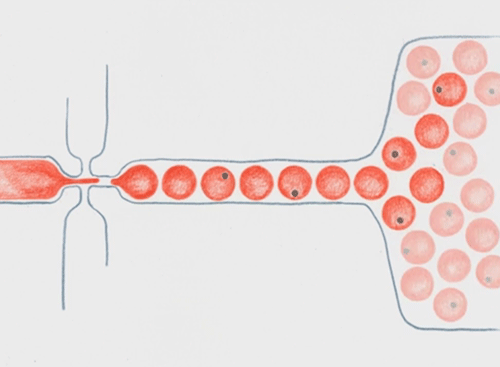News All News
May 28th, 2015
Beyond average: New platforms genetically barcode tens of thousands of cells at a time
By Stephanie Dutchen (HMS News)

Image courtesy of Boston Science Communications.
Imagine someone hands you a smoothie and asks you to identify everything that went into it.
You might be able to discern a hint of strawberry or the tang of yogurt. But overall it tastes like a blend of indiscernible ingredients.
Now imagine that the smoothie is made of 20,000 ground-up cells from, say, the brain.
You could run tests to determine what molecules are in the sample, which is what scientists do now. That would certainly give you useful information, but it wouldn’t tell you which cells those molecules originally came from. It would provide only an average cell profile for the whole smoothie.
And when it comes to the tissues in our bodies, averages are almost always misleading. Just as you know there isn’t an “average” food called strawbanaspinach-orangegurt, scientists know there isn’t just one cell type in the brain.
“If you take a hunk of tissue and grind it up and analyze the RNA, you have no idea if it represents what every cell in that population is doing or what no cell in the population is doing,” said Marc Kirschner, the John Franklin Enders University Professor of Systems Biology and chair of the Department of Systems Biology at Harvard Medical School. “Imagine if you had a population of men and women. If you assume everyone is an average of men and women, you [probably] wouldn’t represent a single person in that population.”
The trouble is, it’s expensive, time-consuming and tricky to characterize tissues one cell, or cell type, at a time.
Kirschner and Steven McCarroll, assistant professor of genetics at HMS, reported this week in separate papers that their labs have developed high-throughput techniques to quickly, easily and inexpensively give every cell in a sample a unique genetic barcode before it goes into the blender.
As a result, scientists can analyze complex tissues by profiling each individual cell—no averaging required.

Image courtesy of Boston Science Communications.
“Different cells in a tissue use the same genome in amazingly diverse ways: to engineer specialized cell shapes, accomplish diverse feats of physiology, and mount distinct functional responses to the same stimulus. These techniques will finally let science understand how biological systems operate at that single-cell level,” said McCarroll, who is also director of genetics for the Stanley Center for Psychiatric Research at the Broad Institute of Harvard and MIT. “We are so excited about the work ahead.”
To make their tools, both teams collaborated with David Weitz, the Mallinckrodt Professor of Physics and Applied Physics at Harvard’s School of Engineering and Applied Sciences and a pioneer in the field of microfluidics.
The teams expect that their techniques, published concurrently in the journal Cell, will equip biologists to discover and classify cell types in the body in much greater depth, map cell diversity in complex tissues such as the brain, better understand stem cell differentiation and gain more insights into the genetics of disease.
Harvard’s Office of Technology Development has been working closely with the researchers to develop patent applications for various aspects of the technology, all with an eye toward commercialization.
Tags: Genetics
Press Contact: Kirsten Mabry | (617) 495-4157
